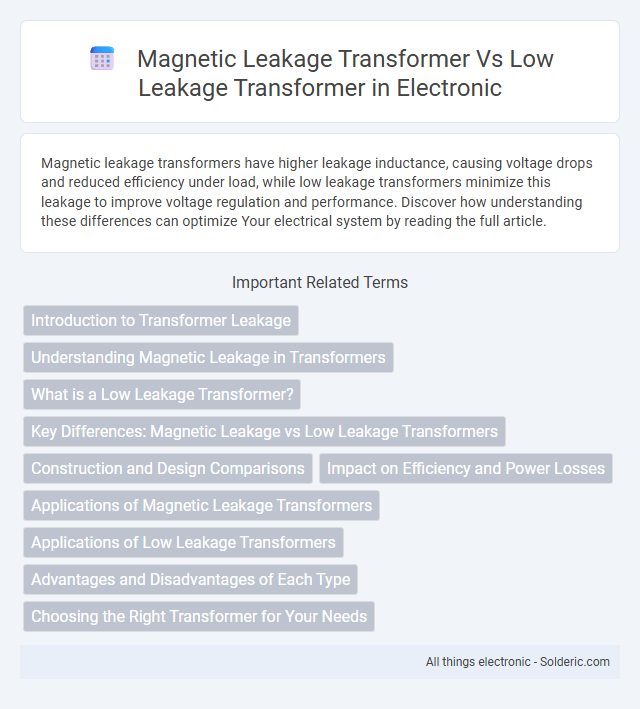Magnetic leakage transformers have higher leakage inductance, causing voltage drops and reduced efficiency under load, while low leakage transformers minimize this leakage to improve voltage regulation and performance. Discover how understanding these differences can optimize Your electrical system by reading the full article.
Comparison Table
| Feature | Magnetic Leakage Transformer | Low Leakage Transformer |
|---|---|---|
| Core Design | Designed to intentionally increase leakage inductance | Optimized to minimize leakage inductance |
| Leakage Inductance | High leakage inductance for limiting fault currents | Low leakage inductance for efficient power transfer |
| Application | Current limiting, arc suppression, welding transformers | General power distribution, minimizing voltage drop |
| Voltage Regulation | Poor voltage regulation due to high leakage | Good voltage regulation with reduced leakage |
| Efficiency | Lower efficiency due to intentional leakage | Higher efficiency with minimal losses |
| Physical Construction | Separated windings to increase leakage flux | Close winding arrangement to reduce leakage flux |
| Typical Uses | Protective devices, specialized industrial applications | General electrical distribution and power supply |
Introduction to Transformer Leakage
Transformer leakage refers to the portion of magnetic flux that does not link both primary and secondary windings, causing energy losses and impacting efficiency. Magnetic leakage transformers exhibit higher leakage inductance due to their winding design, which is beneficial for limiting short-circuit currents and controlling transient voltages in power systems. Low leakage transformers minimize flux leakage by closely coupling windings, enhancing voltage regulation and reducing electromagnetic interference in sensitive electronic applications.
Understanding Magnetic Leakage in Transformers
Magnetic leakage in transformers occurs when a portion of the magnetic flux fails to link both the primary and secondary windings, resulting in energy loss and reduced efficiency. Magnetic leakage transformers are specifically designed to control this flux escape, optimizing performance for applications where controlled leakage inductance is beneficial, such as in welding machines or arc furnaces. Low leakage transformers minimize magnetic flux leakage through precise core design and tight winding coupling, enhancing voltage regulation and efficiency in sensitive electronic and power distribution systems.
What is a Low Leakage Transformer?
A low leakage transformer is specifically designed to minimize magnetic flux leakage by optimizing the core and winding configuration, improving efficiency and reducing electromagnetic interference. Unlike standard magnetic leakage transformers, it ensures tighter coupling between primary and secondary windings, resulting in lower leakage inductance and enhanced voltage regulation. Your choice of a low leakage transformer supports applications requiring precise voltage control and reduced noise in sensitive electronic circuits.
Key Differences: Magnetic Leakage vs Low Leakage Transformers
Magnetic leakage transformers exhibit higher flux leakage due to less optimized core design, resulting in increased energy loss and reduced efficiency. Low leakage transformers minimize magnetic flux leakage through tightly wound coils and improved core geometry, enhancing performance and stability in sensitive electrical applications. Understanding these key differences helps you select the appropriate transformer based on efficiency requirements and application sensitivity.
Construction and Design Comparisons
Magnetic leakage transformers feature a core design that allows higher magnetic flux leakage, achieved by using air gaps or specific winding arrangements, resulting in increased leakage inductance suitable for limiting short-circuit currents. Low leakage transformers are constructed with tightly coupled windings placed close together and a core design optimized to minimize the magnetic flux that escapes the magnetic circuit, thus reducing leakage inductance and improving voltage regulation. The construction differences significantly influence their applications, with magnetic leakage transformers prioritizing current limiting and low leakage transformers emphasizing efficiency and voltage stability.
Impact on Efficiency and Power Losses
Magnetic leakage transformers typically experience higher power losses due to increased flux leakage, which reduces overall efficiency compared to low leakage transformers designed to minimize stray magnetic fields. Low leakage transformers use optimized core designs and winding techniques to contain magnetic flux within the core, significantly decreasing eddy current and hysteresis losses. Improving your system's efficiency depends on selecting low leakage transformers to reduce energy waste and maintain stable voltage regulation.
Applications of Magnetic Leakage Transformers
Magnetic leakage transformers are primarily used in applications requiring controlled leakage inductance to limit short-circuit currents, such as arc welding, induction heating, and current limiting in power distribution. Unlike low leakage transformers designed to minimize leakage for efficient power transfer, magnetic leakage transformers intentionally utilize higher leakage for operational benefits in equipment protection and energy regulation. Your choice of transformer impacts system stability, making magnetic leakage transformers ideal for specialized industrial processes where precise current control is crucial.
Applications of Low Leakage Transformers
Low leakage transformers are commonly used in applications requiring precise voltage regulation and minimal electromagnetic interference, such as in medical equipment, audio devices, and sensitive instrumentation. Their design minimizes magnetic flux leakage, ensuring efficient energy transfer and enhanced performance in high-frequency circuits and power supplies. Industries relying on signal integrity and noise reduction heavily depend on low leakage transformers for optimal operation.
Advantages and Disadvantages of Each Type
Magnetic leakage transformers offer advantages like improved fault tolerance and easier short-circuit protection due to their intentional leakage inductance but suffer from increased energy losses and lower voltage regulation. Low leakage transformers provide better efficiency and voltage stability with reduced leakage inductance, enhancing performance in sensitive electronic equipment, though they are more susceptible to fault conditions and can require complex protection schemes. Your choice depends on whether you prioritize system robustness and protection or energy efficiency and voltage accuracy.
Choosing the Right Transformer for Your Needs
Choosing the right transformer depends on the application's tolerance for magnetic leakage and efficiency requirements. Magnetic leakage transformers exhibit higher magnetic flux leakage, making them suitable for applications with less stringent electromagnetic interference constraints. Low leakage transformers minimize magnetic flux leakage, providing better efficiency and reduced electromagnetic interference, ideal for sensitive electronic equipment and high-precision industrial uses.
magnetic leakage transformer vs low leakage transformer Infographic

 solderic.com
solderic.com